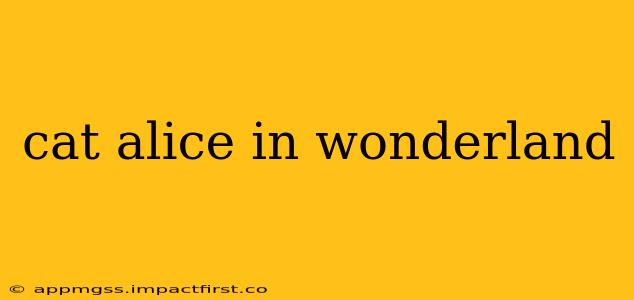Lewis Carroll's "Alice's Adventures in Wonderland," a timeless classic, continues to captivate readers of all ages with its nonsensical narrative, unforgettable characters, and enduring themes. This exploration delves into the depths of this beloved story, examining its enduring appeal and answering some frequently asked questions.
What is "Alice's Adventures in Wonderland" about?
At its core, "Alice's Adventures in Wonderland" follows the fantastical journey of young Alice, who tumbles down a rabbit hole and into a world brimming with bizarre creatures and illogical events. Alice's adventure is a surreal descent into a landscape governed by nonsensical rules and populated by eccentric characters like the Mad Hatter, the Cheshire Cat, and the Queen of Hearts. The story explores themes of identity, growing up, the absurdity of the adult world, and the power of imagination. Alice's experiences challenge logic and reason, prompting reflection on the nature of reality itself. The narrative is less about a coherent plot and more about a series of whimsical encounters and illogical situations that cumulatively create a dreamlike and unforgettable experience.
Who wrote "Alice's Adventures in Wonderland"?
The author of "Alice's Adventures in Wonderland" is Charles Lutwidge Dodgson, who wrote under the pseudonym Lewis Carroll. Dodgson, a mathematician and photographer, created this enchanting tale, drawing inspiration from his own life and interactions with children. His real-life persona was quite different from the whimsical and playful voice he adopted as Lewis Carroll, highlighting the duality often found in great works of art. The book's publication in 1865 launched a literary phenomenon, establishing Carroll's enduring legacy in children's literature.
What are the main characters in "Alice's Adventures in Wonderland"?
Several memorable characters populate Alice's fantastical journey. Alice herself is the protagonist, a curious and observant young girl whose experiences drive the narrative. The White Rabbit, always late, sets the adventure in motion, while the Mad Hatter and the March Hare preside over a nonsensical tea party. The enigmatic Cheshire Cat, known for its disappearing act, offers cryptic advice. The tyrannical Queen of Hearts, prone to outbursts of anger and pronouncements of execution, represents the absurdity of authority. Each character embodies a specific facet of the story's themes, adding layers of meaning to the already rich tapestry of the narrative.
What is the significance of the Mad Hatter's Tea Party?
The Mad Hatter's Tea Party is arguably one of the most iconic scenes in the book. It represents the chaotic and nonsensical nature of Wonderland. The endless tea party, with its illogical rules and perpetually changing seating arrangements, symbolizes the absurdity of societal rituals and the arbitrary nature of rules. The characters' behavior, marked by nonsensical conversations and illogical actions, emphasizes the inherent meaninglessness of some adult interactions as perceived by a child. The scene also touches upon themes of time and its subjective nature, adding a layer of philosophical complexity to the otherwise lighthearted narrative.
What is the meaning of "Alice's Adventures in Wonderland"?
Interpretations of "Alice's Adventures in Wonderland" are varied and plentiful. Some view it as a children's story, purely for entertainment. Others see it as a social commentary, critiquing the rigid structures and nonsensical conventions of Victorian society. Many readers find it to be an exploration of the human experience, touching upon themes of identity, growing up, and the power of imagination. Ultimately, the meaning is subjective, allowing each reader to engage with the story on their own terms and find their own personal resonance within its fantastical narrative. The inherent ambiguity and dreamlike quality contribute to its enduring popularity and its capacity to resonate with different generations and across different cultural contexts. The book's open-endedness allows for endless reinterpretation and continual relevance.
Is "Alice's Adventures in Wonderland" appropriate for children?
While "Alice's Adventures in Wonderland" is a classic children's story, its suitability depends on the child's age and maturity level. The fantastical and often nonsensical nature of the narrative might be overwhelming or confusing for very young children. However, for older children, the book can be an engaging introduction to imaginative literature and a fun exploration of language and storytelling. The presence of potentially frightening characters like the Queen of Hearts should also be considered when deciding if it's appropriate for a particular child. A parent's guidance and interaction can help a child understand and engage with the story more effectively.
This exploration only scratches the surface of the rich tapestry of "Alice's Adventures in Wonderland." The novel's enduring popularity rests on its unique blend of fantasy, satire, and psychological insight, making it a rewarding experience for readers of all ages and backgrounds.
